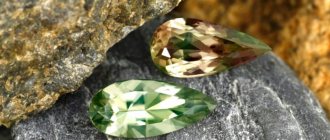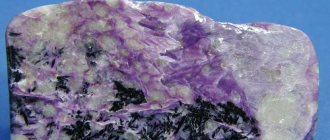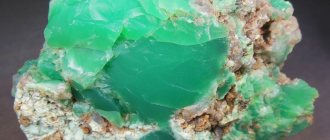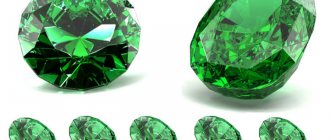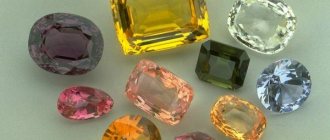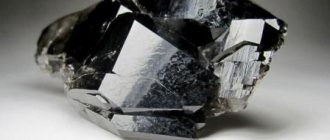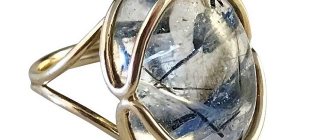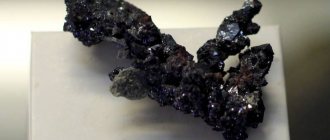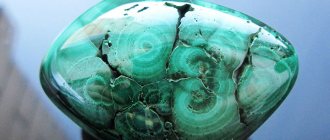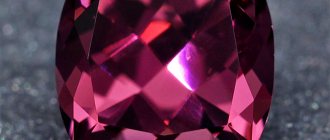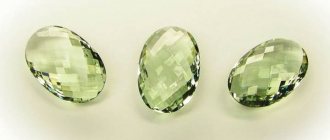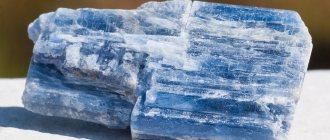There are many mysteries associated with this stone. It is considered semi-precious, but costs the same as a diamond and even more. The natural reserves of such gems are kept secret, so no one will say when they will run out. The color of the mineral cannot be described in one word because it changes depending on the lighting. The name of the “stranger” that all fashionistas in the world dream of is Sultanite.
Description and uniqueness of the stone
Sultanite (diaspora, thanatarite, zultanite) is a symbol of Turkey, a rare semi-precious stone. It has an unusual quality that only 1% of earth's minerals have. Like alexandrite, it can change color, but it has a richer and more varied palette of shades.
Under different lighting angles, the same stone shimmers with yellow, amber, crimson, brown, and rich green shades. Plus, it gives off lots of sparkling highlights. By purchasing a product with a diaspora, you can get the effect of several decorations that can be easily combined with different wardrobe items.
It is transparent, like sapphire or ruby, but very fragile. The chemical composition of sultanite includes two main components - corundum (75%) and water (25%), therefore mineralogists call it watery corundum.
Although corundum is known for its hardness, this gem is unusually fragile. Due to increased fragility, up to 97% of the original weight of nuggets is lost during processing and mining. The fragility of sultanite is explained by the fact that it contains hydrogen ions, which destroy the atoms of the crystal.
In addition to fragility, the mineral has the following physical characteristics:
- Hardness – 6.5/10 on the Moss scale.
- Density – 3.5 g/cm3.
- Pearlescent or glassy luster.
- Opaque or translucent.
- Color - from white, colorless, pale yellow to pink, lilac, brown and all kinds of shades of green.
According to cutters, such a stone is collected from the surface of the Earth once every 5 years, so the mineral is considered rare and is sold at the price of cut diamonds.
Origin of the mineral
Sultanite is known in the world as the Turkish stone that changes color. In fact, the mineral was first discovered 200 years ago in the Urals near the village of Kosoy Brod. The gems were found by chance while mining iron ore. They were given the name “ferruginous kyanite,” but this name did not stick.
The specimens found in Russia were so small that they could not be cut, so the find was not given much significance. Joseph Tanatar, a Russian professor, Doctor of Geological and Mineralogical Sciences, began studying the unfamiliar stone. He compiled a detailed description of the mineral. In honor of the talented scientist, the gem was named thanatarite.
The French geologist Rene Justa Gaüy became interested in the Ural gem. He discovered that the chameleon stone cracked when heated. For this quality, he dubbed the mineral diaspore, which translated from ancient Greek means “crumbly.” The name has taken hold in European countries, where it is still considered the official name of the mineral.
For two centuries, thanatarite remained exclusively the property of mineralogists and collectors, but in the 70s of the twentieth century, in one of the mountainous regions of Turkey - Anatolia - a deposit of diasporas of rare beauty was found. At first, the sultans' stone was mined illegally and smuggled to Europe.
Later, Millennium Mining Co. received a mining and export license. To this day, it remains the only official supplier of raw diaspora to other countries.
The owner of this concern, Murat Akgun, decided to perpetuate the famous dynasty of 36 sultans, which ruled Turkey since the 13th century. He awarded the stone, which changes color depending on the light, the telling name sultanite. In Turkish it is pronounced zultanit.
A little history
This stone was mentioned by ancient eastern sages. The sultans wore rings with this rare stone, decorated their clothes with it, and gave it to their numerous wives and concubines. This is probably where its Russian name came from.
This mineral is rarely found in our Urals. The Ural sultanite is small and fragile, and is of no interest to jewelers. However, it was first discovered there, near the village of Kosoy Brod in the vicinity of Yekaterinburg.
This stone is also called diaspora, thanatarite and zultanite.
Diaspora is its most common and oldest name. It is translated from Greek as “scattering.” The stone is fragile, cannot withstand heat - it cracks and breaks into grains.
The term "diaspore" was introduced by the Frenchman R.J. Rene Just Hauy in 1801. This crystallographer was the first to describe the mineral. Previously, in the Urals, diasporas were called “ferruginous kyanite.” The chemical composition of this stone is corundum containing water.
The name thanatarite is Russian, it was given to the stone in memory of the Russian geologist Joseph Isaakovich Thanatar (1880 - 1961).
Jewelry varieties from Turkey are called Zultanite, we say sultanite.
Where is sultanite mined?
High-quality samples of zultanite, which have jewelry value, are mined in Turkey. Large deposits of such minerals are located near the village of Selimiye in the Ilbir Mountains. The stone is fragile, so when mined, 97-98% of gems go to waste. Only 2-3% of the total amount of mined raw materials turns into sparkling jewelry after processing.
The Turkish government does not disclose the natural reserves of sultanite on its territory. Nobody knows how many there are, so purchasing such a stone is considered a profitable investment.
Sultanites are found in Europe. There are small deposits in Norway and Hungary. Diaspore is mined on the island of Madagascar. In Africa, mineral deposits were discovered in the Kalahari Desert. The USA also has natural reserves of these gems. They are located in Massachusetts.
In Russia, the development of such stones is carried out at the Kosobrodskoye and Saranovskoye deposits, located in the Urals. The many-sided mineral is also mined in Yakutia. It is found in China, Australia, Azerbaijan, and Uzbekistan.
The sultanite stone is still considered rare.
The fact is that diasporas from other countries are significantly inferior in quality and quantity of shades to Turkish gems. They are processed and mounted, but due to their small size and opacity they are not considered valuable.
Place of Birth
Diaspora deposits are located throughout the world in the territories of many states. Non-jewelry mineral is found on the following lands:
- Russia (Yakutia, Ural).
- China.
- Uzbekistan.
- Hungary.
- USA.
- Azerbaijan.
The place where jewelry sultanite is mined is the Ilbir Mountains, located in the southeastern part of Turkey. The deposit is unique, as it is the only one on the planet. The Turkish authorities keep the reserves of the nugget, as well as any information about it, in strict secrecy.
Jewelry value of the stone
Turkish sultanite has been officially used for making all kinds of jewelry since 1994. Skilled craftsmen make everything from the faceted mineral, except beads and bracelets. Women choose dazzling earrings, rings and pendants made from stones that change color at different times of the day and in different lighting.
Wearing such jewelry is fashionable and prestigious. Men prefer luxurious rings that indicate the high social level and material well-being of their owners.
The bright beauty of diaspora is best set off by a silvery sheen, which is why it is set in platinum and silver. All the luxury and depth of the stone is also manifested in combination with gold. The capricious mineral does not tolerate proximity to low-grade metals. Framed with such material, it darkens and fades. This diaspora property has been used in the past to determine the authenticity of gold.
The larger the size of the stone, the more pronounced is the ability of sultanite to change color depending on the lighting.
Jewelry made from natural sultanite is an expensive pleasure. The price of such products is not affordable for every lover of precious stones; it is:
- for a ring: set in silver – from 3 to 5 thousand rubles, in gold – 9-15 thousand rubles;
- earrings: silver – 3-10 thousand rubles, gold – 15-30 thousand rubles;
- pendant: 2-4 thousand rubles. (in silver), 4-7 thousand, if the stone is inserted into a frame made of precious metal.
Color spectrum
Thanatarites that do not contain impurities are found in nature. They are completely transparent. Such stones are not considered valuable. They are of no interest from a jewelry point of view.
Colored stones are popular and in demand:
- Pink - include manganese.
- Amber, yellow-brown - contain iron.
- Different shades of green. Such samples contain chromium impurities.
Diasporas of greenish-pink and pink-brown shades are recognized as the most valuable in the jewelry world.
Medicinal properties
This is a “young” mineral. People met him two centuries ago. In the past, healers did not use the Sultan’s stone for treatment, so Thanatarite did not have time to establish itself in alternative medicine.
Diaspora is a natural formation. In esotericism, it is believed that all minerals store the energy of the Cosmos, and therefore are able to influence health. People have yet to learn about the healing talents of the sultanite.
Today it is known that it has the following medicinal properties:
- accelerates recovery from viral infections;
- relieves pain in the spine;
- has a positive effect on the functioning of the heart;
- strengthens the immune system;
- calms, relieves depression.
We are treated with sultanite
According to lithotherapists, wearing jewelry with sultanite will help planned weight loss and ease the course of cardiovascular diseases. Diaspora brings relief from Parkinson's disease and reduces symptoms of depression.
The healing properties of sultanite are small. It will help cure colds and, as an additional therapy, will provide relief from back pain.
Lithotherapists consider the mineral to be a kind of indicator of human health and vitality. A talisman with a diaspora will warn the owner in advance about an approaching illness (or financial losses). If a gem fades, loses color, or even crumbles into crumbs, this means possible problems in the body. Urgently go to the doctors for examination (God saves the best).
Magic properties
Psychics could not ignore such a unique stone. They studied its energy and determined that the sultanite is able to foresee tragic events. The mineral senses the approach of misfortune or danger. If the owner of the stone is in danger, the diaspora cracks or becomes cloudy. In magic, the chameleon mineral is used as a predictor.
Sultanite is not used for mystical rituals that can harm a person. He does not perceive negative energy and is unable to transmit it. This is a talisman for people who are creative. It gives inspiration and awakens bright thoughts. Zultanite is suitable for artists, poets, musicians, actors, playwrights.
Mystical properties of the sultanite stone:
- Develops intuition. Strengthens and cleanses the human aura.
- Attunes to a philosophical perception of life. The stone is suitable for meditation. It calms you down, makes you forget about adversity and everyday trifles, and think about the eternal. To come into harmony with nature, you need to put it in front of you and peer into the depths of the mineral for 15 minutes.
- Becomes a shield from energy vampires.
- Helps scientists make discoveries. Strengthens self-confidence and gives impetus to daring endeavors.
- Enhances supernatural abilities - helps fortune tellers and sorceresses look into the future. To find out what fate has in store for a person, a special ritual is performed. You need to continuously look deep into the iridescent crystal for several minutes, holding it in your hands. Then the sorceress mercilessly throws the mineral into the fire. The stone is cracking. The fortune teller uses the cracks to determine the future.
- Sets you up for positivity. If a person is feeling sad, he can gently rub the stone. This will improve your mood and dispel sad thoughts.
In Europe and the USA, sultanite is equally popular among women and men. For representatives of the stronger sex, it is valuable because it develops fortitude. This stone helps girls make informed decisions dictated not by the heart, but by the mind.
It is believed that the magical properties of the stone are most strongly revealed if expressed by the numbers 7 and 5, that is, the happiest mineral will be a mineral weighing 7.77 or 5.55 ct. Silver enhances the predictive abilities of sultanite, so psychics use minerals set in this metal.
What stones does it go with?
Sultanite is a “livable” mineral. It shimmers in different colors, so it can be combined with many stones. The only condition is that you cannot combine diasporas and costume jewelry in one product. Such proximity will spoil its appearance. It will lose its shine and become cloudy.
Compatibility of sultanite with other stones:
- high - with pearls, diamonds, onyx, other green, white, black minerals and transparent crystals;
- medium - with agate, turquoise, aquamarine, as well as purple, blue, blue stones;
- weak - with ruby, tourmaline and other minerals of red shades.
Which zodiac signs are sultanite suitable for?
Astromineralogists have determined that sultanite belongs to the element of Fire, therefore it is most suitable for fire signs and comes into conflict with those who, according to the horoscope, belong to the element of Water. This does not mean that it cannot be worn by those whose zodiac sign is Pisces, Scorpio or Cancer. Thanatarite will not harm them, but it will not improve their fate either.
Interaction of sultanite with different zodiacal constellations:
- Aries, Sagittarius, Leo - will reveal creative abilities, sharpen the “sixth sense”, strengthen family and friendships, and relieve excessive sentimentality. Wearing this mineral will help representatives of such signs soberly assess current events and recognize the true intentions of others.
- Gemini, Libra, Aquarius - will bring stability into their lives, make them think about the meaning of existence and the correctness of the chosen path. If someone harbors a grudge or is hatching plans for revenge, then the Sultanite will calm these passions and help forgive the offender. Having found peace of mind, a person will feel healthy and full of strength. He will have ambitious plans.
- Capricorns, Virgos, Taurus - will improve your personal life, help you find a soul mate, make a person more sociable and friendly, bestow wisdom, teach you to avoid conflicts.
- Scorpios, Pisces, Cancers - the Sultanite will have a calm relationship with them. The stone will give water signs confidence and teach them to look at life with optimism.
Astrological affiliation
Most astrologers claim that the padishah stone is suitable for almost all zodiac signs, with some exceptions. Each person will feel a different effect of the amulet.
(“+++” – the stone fits perfectly, “+” – can be worn, “-” – is strictly contraindicated):
| Zodiac sign | Compatibility |
| Aries | +++ |
| Taurus | + |
| Twins | + |
| Cancer | + |
| a lion | +++ |
| Virgo | + |
| Scales | + |
| Scorpion | + |
| Sagittarius | + |
| Capricorn | + |
| Aquarius | + |
| Fish | + |
Unusually beautiful crystal and stones
- Aries will reveal their unknown talents, become calmer, more simple-minded, and more patient. For Aries with philosophical thinking, the talisman will prompt them to search for extraordinary solutions and put forward incredible theories.
- Leos will feel a surge of strength and desire to implement their creative ideas. The stone will give them the faith that everything planned will be realized.
- Taurus will be able to perform the actions necessary for a specific time and place. This trait will help them arrange their personal life.
- Virgos are guaranteed to gain romanticism, optimism and daydreaming. At the same time, a share of practicality will also come into their lives.
- Scorpios, along with Virgos, will become romantics, which will somewhat smooth out their natural prudence. Scorpio women will look more charismatic and charming with such a talisman.
- Libra, with their changeable nature, needs sultanite more than anyone else. The stone will help you set life priorities, making Libra’s character more stable.
- Sagittarius will acquire the missing balance and patience. And long-term interaction with the mineral will to some extent awaken extrasensory abilities in Sagittarius.
- Aquarians are pragmatists by nature. The eastern gem will help them to relax, to look at the world through the eyes of a romantic and a dreamer.
- For Capricorns, the amulet promises harmony of feelings. When it comes to concentrating on work, Capricorns will be pragmatists. When the time comes for romance, they will easily adjust to the right mood.
The stone will not bring anything to the other signs; it can only be worn for beauty.
Is this stone right for you?
How to distinguish from a fake
Large, high-quality specimens of natural sultanite are rare, and the demand for the unusual mineral is constantly growing. Chemical engineers set out to solve this problem. They created a synthetic analogue of the chameleon mineral - hydrothermal sultanite. It was obtained by aging alumina hydrate gel. To produce the double, natural raw materials are used - crumbs of natural gems.
Russian specialists from the Rusgams company have developed and patented a technology that has made it possible to create another artificial analogue of such a stone - glass ceramic. It is produced on the basis of silicon dioxide and aluminum oxide at a temperature of 1700 °C. Using the same method, it was possible to synthesize 10 varieties of stones with an alexandrite effect.
In appearance and physical qualities, it is an exact copy of a natural mineral, but its strength is higher, and therefore it is much easier to process such material. Making synthetic prototypes is cheaper than mining natural nuggets.
Currently, most jewelry is made from artificial mineral, which has no healing or magical properties. Natural and synthetic samples differ from each other in color transitions, but only a gemologist can detect such a discrepancy.
It is impossible for an ordinary buyer without special equipment to distinguish a fake from a real stone. By law, the manufacturer is required to indicate the origin of the mineral on the price tag, but not all jewelry manufacturers comply with this requirement.
Two ways to distinguish natural sultanite from “fake” one:
- Marking. Carefully examine the stone, if the letters are written on the tag: “g/t” - short for hydrothermal or glass-ceramic, it means they are synthesized artificially.
- Price. Natural sultanite is an expensive stone. The cost for 1 carat reaches $100, which is comparable to the price of a diamond. If a seller offers jewelry with a diaspora, which costs much less, then this is a skillful fake. Hydrothermal twin and glass ceramic are valued about the same as topaz and garnet.
Note
Sultanite is an incredibly beautiful and rare mineral. It is worth paying attention to as a luxurious decoration, as well as an item for financial investment. Synthetic analogues of stone will definitely please customers with a limited budget. After all, you will have to literally breathe on an expensive stone - careless handling will lead to irreparable loss. With analogues everything is simpler and cheaper. But it is worth remembering that only a natural nugget will serve not only as an accessory, but also as a magical talisman.
How to care for stone
Natural sultanite is a capricious stone. Due to its high fragility, it will crack from any careless movement accompanied by a fall. It should not be handled with dirty hands; greasy marks will be left on it. It will no longer be possible to remove such marks.
Zultanite requires delicate handling. If you have jewelry with this mineral or an unset stone (which seems doubtful), follow these care rules:
- Wash periodically in cool water and mild soap.
- Do not drop or subject to mechanical shock.
- Do not clean Thanatarite with rough sponges.
- Do not use household chemicals to remove contaminants that appear on the mineral.
- Do not expose sultanite to sudden temperature changes. Do not take it out of a warm room into the street if it is freezing there. Leave the chameleon stone at home.
- Do not heat the diaspore - it will burst.
- Do not allow acids or solvents to come into contact with the surface of the mineral.
- After washing, wipe the gem with a soft cloth. This will restore shine.
To prevent the gem from falling apart, keep it in a soft box, separate from other jewelry and minerals.
In Turkey, these stones began to be mined and processed only half a century ago, but a legend has already developed about their origin. It says that iridescent gems were worn exclusively by sultans, who presented such jewelry to their wives and concubines. Although this is a beautiful myth, sultanite is truly a strange mineral. It is a pity that it is almost impossible to buy the original. Instead of natural stone, its synthetic “brothers” are often on sale.
Sultanite magic
Place a magic stone under your pillow and your dreams will be bright and memorable.
Diaspora magic neutralizes “energy vampires.” They will not be able to start a quarrel or scandal if you are protected by a piece of jewelry with an iridescent gem.
Those who practice fortune telling know that the gem stimulates psychic abilities.
It’s interesting: soothsayers and fortune tellers throw a stone into the fire, and from the resulting cracks they predict the future of the client. We recommend: Precious mineral BLUE SAPPHIRE
The magical properties of sultanite are suitable for writers, scientists, and poets. The stone will help you find the right metaphors, bright aphorisms, colorful epithets.
Sultanite is a stone for humanists and people of creative professions.
The gem is favorable to scientists and philosophers. The diaspora will help them find innovative solutions to problems and stimulate the development and implementation of new project ideas.
Amulets made from sultanite will help you finish what you start.
